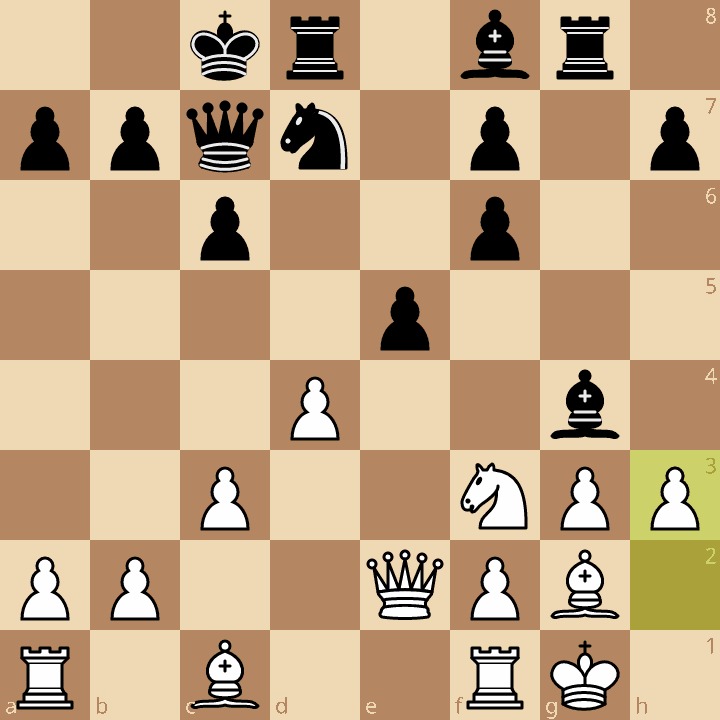Rapid Game Recap: Cameron Park Classic Round 3
Round 3. After facing an unnecessary loss, I was ready to play another game and bounce back. My opponent was newer to chess. I think this may have been one of his first tournaments. Despite only playing the game for perhaps a year, he played very solidly and defended well for a long time. New players these days simply are not pushovers. Especially if they play the Caro-Kann. Ugh.
Time Control: 15 minutes + 10 second increment
White: Me (1565 USCF)
Black: 948 USCF
1.e4 c6
The Caro-Kann Defense. To be honest, I have some ambivalent feelings towards this defense. It’s not really anybody’s fault. I sometimes struggle in these positions because it is not always simple to know if White should press for an attack and how sound it is to push on either wing for an attack. The Caro-Kann is a great opening that gets a playable middlegame for Black.
2.Nc3
Heading for the Two Knights Variation. I often play 2.d4 and head for the Advance Variation after 2…d5 3.e5, however, I had had some recent successes in blitz games, and wanted to try something differently.
2…d5
Invariably played by Caro-Kann players.
3.Nf3 dxe4
This is the most common response at the club level, but 3…Bg4 has been played more often by masters. To be quite honest, 3…Bg4 is the reason I don’t typically play this line. Black seems to equalize quite well.
4.Nxe4 Nf6 5.Qe2
This move sets a little trap. Given my opponent’s relative lack of experience, I was curious how he would respond.
5…Bg4?!
This move seems like a huge inaccuracy to me. White gets to trade on f6 and ruin black’s kingside structure. The committal nature of the move Bg4 means that the resulting semi-open g-file isn’t easy for Black to utilize. Overall, I think the better option is 5…Nxe4 6.Qxe4. Some players (even at my level) fall into the trap: 5…Nbd7?? which unceremoniously loses the game to 6.Nd6#
6.Nxf6 gxf6 7.c3?!
Trading an inaccuracy in turn. The intent is to prepare the move d4.
7…Nd7
Not bad, but Black could have equalized perfectly with 7…Qd5. With nothing capable of attacking the queen, Black has a dominant position in the center and White will have trouble making any sort of progress towards a superior position. For instance 8.d4 Nd7 9.Bd2 and if anyone is better, it’s Black.
8.d4 Qc7 9.g3
Seeing as e2 is occupied by the queen, it makes sense to put the bishop on the long diagonal. It’s not typical of me to assume this configuration for White, but I think it’s a pretty nice plan.
9…O-O-O 10.Bg2 Rg8?!
This rook probably does better supporting a future h-pawn push. Breaking in the center with 10…e5! or pressuring the kingside with 10…h5! both look like better options.
11.O-O e5!?
This looks principled. I still wonder if 11…h5 would have been more practical, but getting this break in does give Black a bit more play in the center. My opponent was proud of him. In our post-mortem we both agreed it looked right.
12.h3
Putting the question to the bishop and attempting to relieve a bit of pressure from my currently-static position. 12.Qc2 was probably a bit better. 12.Qd2 wasn’t quite as strong because then it blocks the other bishop.
12…Be6!
A mature decision! After 12…Bxf3 13.Qxf3, White would dominate the center with a lot of pressure towards the kingside.
13.c4!?
The plan is to push d5. 13.Rd1 was a bit more accurate. In all the possible variations, Black has the resource Nb6, which opens the rook on the d-file towards the center and giving Black some ideas involving the occupation of the c4 square. After 13…Nb6 14. dxe5 Rxd1+ 15.Qxd1 fxe5 16.Ng5, White’s a bit better but the position isn’t anywhere close to resolved.
13...Re8?!
13…Nb6 was better, preventing White’s next. For instance: 14.d5? cxd5 15.cxd5 Nxd5 16.Bd2 Kb8 and White is down a pawn with no compensation. 13…exd4 14.Nxd4 was not as strong.
14.d5!
This sacrifice seemed really strong based on the opening of the c-file as well as opening up the g1-a7 diagonal.
14…cxd5 15.cxd5 Bxd5 16.Rd1
This is the simplest idea, preparing Be3 and Ra(d)c1. 16.Be3 didn’t look that strong at first, but Stockfish found some interesting plans and the move itself is principled. 16…Bc4 17.Qd1 Bxf1 18.Rc1 Bc4 19.Nd2 b5 20.a4 a6 21.axb5 axb5 22.Nxc4 (if 22.b3 then 22…Bc5) bxc4 23.Qa4! This turns out to be rather strong since Rxc4 is coming and the Black king is short on cover. Of course, this is a Stockfish line, and I’d never see this idea over the board.
16…Bc6
Now the moment is really shifting as my opponent continues to respond to my plans. 16…Qc4!, offering a trade, was more active and a stronger idea. The text move is way too compliant.
17.Be3 Kb8 18.Rac1
In my opinion, this is a rather beautiful position for White. Down a pawn, but every single piece is active. The Rooks control all the important files, and pin the bishop to the queen. Nd2 (or any other knight move, for that matter) opens the diagonal up for the g2 bishop as well.
18…Bd6 19.Nd2?!
This is not bad, but 19.b4 Bxb4 20.Rxc6 bxc6 (20…Qxc6 21.Nxe5!) 21.Rb1 a5 22.a3 was much more violent.
19…Bxg2??
My opponent over looks that his bishop was pinned. From this point forward it’s a straightforward victory.
20.Rxc7 Kxc7 21.Kxg2 Nb6 22.Rc1+ Kb8 23.Bxb6 axb6 24.Ne4 Be7 25.Qb5 f5 26.Qxe5+ Ka7 27.Qxf5 Rgf8 28.Rc4 Rd8 29.Ra4+ Kb8 30.Qe5+ 1-0
At this moment my opponent made an illegal move, then resigned.
I had a great position for almost the entirety of the game. My main takeaway was found in analysis not to allow my opponent to centralize easily. Allowing 7…Qd5 was a pretty glaring strategic mistake and I’m lucky my opponent did not find it.
Full GIF of the game:










